- Paragraph Generator
- Cover Letter
- Authorization Letter
- Application Letter
- Letter of Intent
- Letter of Recommendation
- Business Plan
- Incident Report
- Reference Letter
- Minutes of Meeting
- Letter of Resignation
- Excuse Letter
- Research Proposal
- Job Application
- Acknowledgement
- Employment Letter
- Promissory Note
- Business Proposal
- Statement of Purpose
- Offer Letter
- Deed of Sale
- Letter of Interest
- Power of Attorney
- Solicitation Letter

Research Interest Statement
Research interest statement format, research interest statement samples, what is a research interest statement, basic elements of the research interest statement , purpose of the research interest statement, how to create a research interest statement, how to make an engaging research interest statement, what are some examples of research interest statements, how long should a research interest statement be, does the research interest statement need references, what should i avoid when writing a research interest statement.

1. Introduction
- Briefly introduce yourself, your background, and your interest in the research area.
- Mention your current academic/professional standing and the field of study.
2. Research Background
- Provide a summary of your previous research or academic projects.
- Highlight the key outcomes, methodologies, and relevance of your work to your current interests.
- If applicable, mention collaborations or publications.
3. Current Research Interests
- Clearly outline your current research interests and how they align with the program or faculty you are applying to.
- Identify specific problems or questions you want to explore.
- Mention how these interests align with recent trends or developments in the field.
4. Future Goals
- Discuss your short-term and long-term research goals.
- Explain how your proposed research contributes to the field and broader societal impact.
- Highlight how the program or institution supports your aspirations.
5. Closing Statement
- Reaffirm your enthusiasm and readiness for the opportunity.
- Mention your eagerness to contribute to and learn from the program or institution.

University Research Interest Statement

Student Research Interest Statement

Research Interest Statement for Faculty Position

Graduate School Research Interest Statement

Research Interest Statement Template

Research Interest Statement Outline
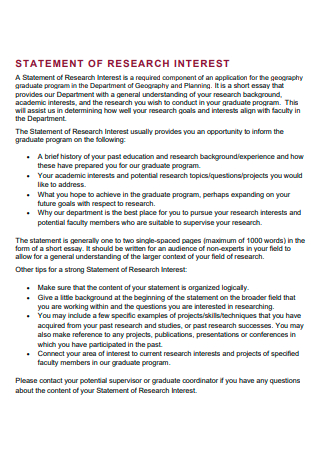
Basic Research Interest Statement

Research Interest Statement Example
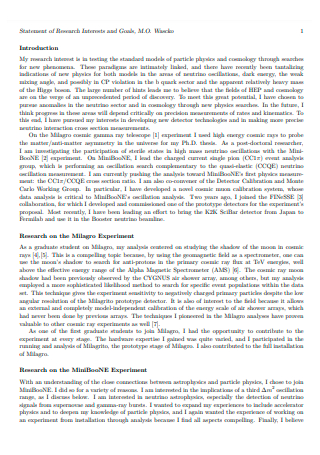
Research Interest and Goals Statement
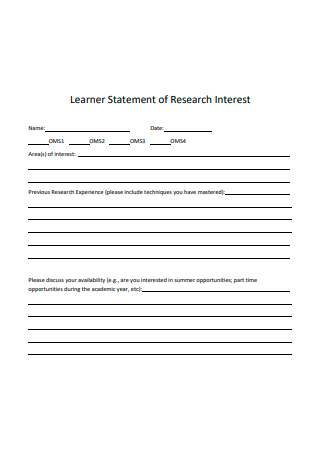
Research Interest Learner Statement
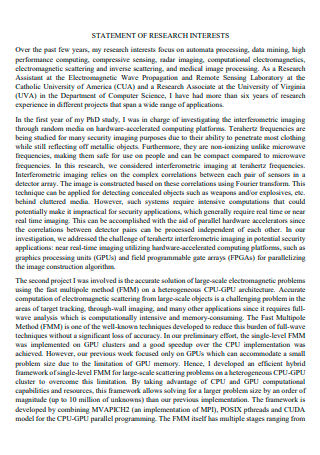
Research Interest Statement in PDF

Research Interest and Career Goals Statement
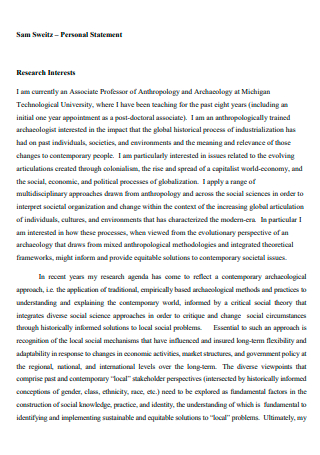
Research Interest Personal Statement

Standard Research Interest Statement

Department of Computer Science Research Interest Statement

Formal Research Interest Statement

Draft Research Interest Statement

Research Interest and Vision Statement

Printable Research Interest Statement

Current and Future Research Interest Statement

Sample Research Interest Statement

Research Experience and Interest Statement

Doctor of Education Research Interest Statement

Research Interest and Philosophy Statement

Simple Research Interest Statement

Research Interest Unit Statement

Leadership Research Interest Statement

Step 1: Reflect on Your Research Journey
Step 2: define your research focus, step 3: highlight past achievements, step 4: align with the institution or program, step 5: outline future aspirations, share this post on your network, you may also like these articles, billing statement.

A billing statement is a vital financial document that provides a detailed summary of transactions, payments, and outstanding balances for a specific period. It helps individuals and businesses keep…
Suitability Statement

A Suitability Statement is a concise document that highlights an individual’s or organization’s qualifications, experience, and suitability for a particular role, project, or opportunity. It serves as a tailored…
browse by categories
- Questionnaire
- Description
- Reconciliation
- Certificate
- Spreadsheet
Information
- privacy policy
- Terms & Conditions
/images/cornell/logo35pt_cornell_white.svg" alt="research interest sample for phd application"> Cornell University --> Graduate School
Research statement, what is a research statement.
The research statement (or statement of research interests) is a common component of academic job applications. It is a summary of your research accomplishments, current work, and future direction and potential of your work.
The statement can discuss specific issues such as:
- funding history and potential
- requirements for laboratory equipment and space and other resources
- potential research and industrial collaborations
- how your research contributes to your field
- future direction of your research
The research statement should be technical, but should be intelligible to all members of the department, including those outside your subdiscipline. So keep the “big picture” in mind. The strongest research statements present a readable, compelling, and realistic research agenda that fits well with the needs, facilities, and goals of the department.
Research statements can be weakened by:
- overly ambitious proposals
- lack of clear direction
- lack of big-picture focus
- inadequate attention to the needs and facilities of the department or position
Why a Research Statement?
- It conveys to search committees the pieces of your professional identity and charts the course of your scholarly journey.
- It communicates a sense that your research will follow logically from what you have done and that it will be different, important, and innovative.
- It gives a context for your research interests—Why does your research matter? The so what?
- It combines your achievements and current work with the proposal for upcoming research.
- areas of specialty and expertise
- potential to get funding
- academic strengths and abilities
- compatibility with the department or school
- ability to think and communicate like a serious scholar and/or scientist

Formatting of Research Statements
The goal of the research statement is to introduce yourself to a search committee, which will probably contain scientists both in and outside your field, and get them excited about your research. To encourage people to read it:
- make it one or two pages, three at most
- use informative section headings and subheadings
- use bullets
- use an easily readable font size
- make the margins a reasonable size
Organization of Research Statements
Think of the overarching theme guiding your main research subject area. Write an essay that lays out:
- The main theme(s) and why it is important and what specific skills you use to attack the problem.
- A few specific examples of problems you have already solved with success to build credibility and inform people outside your field about what you do.
- A discussion of the future direction of your research. This section should be really exciting to people both in and outside your field. Don’t sell yourself short; if you think your research could lead to answers for big important questions, say so!
- A final paragraph that gives a good overall impression of your research.
Writing Research Statements
- Avoid jargon. Make sure that you describe your research in language that many people outside your specific subject area can understand. Ask people both in and outside your field to read it before you send your application. A search committee won’t get excited about something they can’t understand.
- Write as clearly, concisely, and concretely as you can.
- Keep it at a summary level; give more detail in the job talk.
- Ask others to proofread it. Be sure there are no spelling errors.
- Convince the search committee not only that you are knowledgeable, but that you are the right person to carry out the research.
- Include information that sets you apart (e.g., publication in Science, Nature, or a prestigious journal in your field).
- What excites you about your research? Sound fresh.
- Include preliminary results and how to build on results.
- Point out how current faculty may become future partners.
- Acknowledge the work of others.
- Use language that shows you are an independent researcher.
- BUT focus on your research work, not yourself.
- Include potential funding partners and industrial collaborations. Be creative!
- Provide a summary of your research.
- Put in background material to give the context/relevance/significance of your research.
- List major findings, outcomes, and implications.
- Describe both current and planned (future) research.
- Communicate a sense that your research will follow logically from what you have done and that it will be unique, significant, and innovative (and easy to fund).
Describe Your Future Goals or Research Plans
- Major problem(s) you want to focus on in your research.
- The problem’s relevance and significance to the field.
- Your specific goals for the next three to five years, including potential impact and outcomes.
- If you know what a particular agency funds, you can name the agency and briefly outline a proposal.
- Give broad enough goals so that if one area doesn’t get funded, you can pursue other research goals and funding.
Identify Potential Funding Sources
- Almost every institution wants to know whether you’ll be able to get external funding for research.
- Try to provide some possible sources of funding for the research, such as NIH, NSF, foundations, private agencies.
- Mention past funding, if appropriate.
Be Realistic
There is a delicate balance between a realistic research statement where you promise to work on problems you really think you can solve and over-reaching or dabbling in too many subject areas. Select an over-arching theme for your research statement and leave miscellaneous ideas or projects out. Everyone knows that you will work on more than what you mention in this statement.
Consider Also Preparing a Longer Version
- A longer version (five–15 pages) can be brought to your interview. (Check with your advisor to see if this is necessary.)
- You may be asked to describe research plans and budget in detail at the campus interview. Be prepared.
- Include laboratory needs (how much budget you need for equipment, how many grad assistants, etc.) to start up the research.
Samples of Research Statements
To find sample research statements with content specific to your discipline, search on the internet for your discipline + “Research Statement.”
- University of Pennsylvania Sample Research Statement
- Advice on writing a Research Statement (Plan) from the journal Science
Purdue Online Writing Lab College of Liberal Arts
Graduate School Applications: Writing a Research Statement

Welcome to the Purdue OWL
This page is brought to you by the OWL at Purdue University. When printing this page, you must include the entire legal notice.
Copyright ©1995-2018 by The Writing Lab & The OWL at Purdue and Purdue University. All rights reserved. This material may not be published, reproduced, broadcast, rewritten, or redistributed without permission. Use of this site constitutes acceptance of our terms and conditions of fair use.
What is a Research Statement?
A research statement is a short document that provides a brief history of your past research experience, the current state of your research, and the future work you intend to complete.
The research statement is a common component of a potential candidate’s application for post-undergraduate study. This may include applications for graduate programs, post-doctoral fellowships, or faculty positions. The research statement is often the primary way that a committee determines if a candidate’s interests and past experience make them a good fit for their program/institution.
What Should It Look Like?
Research statements are generally one to two single-spaced pages. You should be sure to thoroughly read and follow the length and content requirements for each individual application.
Your research statement should situate your work within the larger context of your field and show how your works contributes to, complicates, or counters other work being done. It should be written for an audience of other professionals in your field.
What Should It Include?
Your statement should start by articulating the broader field that you are working within and the larger question or questions that you are interested in answering. It should then move to articulate your specific interest.
The body of your statement should include a brief history of your past research . What questions did you initially set out to answer in your research project? What did you find? How did it contribute to your field? (i.e. did it lead to academic publications, conferences, or collaborations?). How did your past research propel you forward?
It should also address your present research . What questions are you actively trying to solve? What have you found so far? How are you connecting your research to the larger academic conversation? (i.e. do you have any publications under review, upcoming conferences, or other professional engagements?) What are the larger implications of your work?
Finally, it should describe the future trajectory on which you intend to take your research. What further questions do you want to solve? How do you intend to find answers to these questions? How can the institution to which you are applying help you in that process? What are the broader implications of your potential results?
Note: Make sure that the research project that you propose can be completed at the institution to which you are applying.
Other Considerations:
- What is the primary question that you have tried to address over the course of your academic career? Why is this question important to the field? How has each stage of your work related to that question?
- Include a few specific examples that show your success. What tangible solutions have you found to the question that you were trying to answer? How have your solutions impacted the larger field? Examples can include references to published findings, conference presentations, or other professional involvement.
- Be confident about your skills and abilities. The research statement is your opportunity to sell yourself to an institution. Show that you are self-motivated and passionate about your project.
My PhD Application Research Statement
I am committed to making the PhD application process more open and clearer to new students, since it is my view that the unnecessary opaqueness of the status quo mostly serves to discourage minorities from applying and to preserve power in the hands of elites. Therefore, I share below the personal statement I used when applying to graduate school in 2018, in hopes it may help someone down the road. I added some comments in square brackets to explain my intended purpose for each section.
Of course, it must come with a big disclaimer: I am not in any way claiming that this is a good statement, let alone a model for others’ statements, nor making any promises about your success if you follow this advice. Also, note that the fact that I am posting this online means that this text will appear in an online search, so you probably don’t want to copy specific words or phrases ;)
Personal Statement
To whom it may concern,
[This first paragraph is a very brief summary which answers the questions “who am I?”, “what am I applying for?”, “why should you hire me?” The rest of the statement serves as a justification for the pitch made in this paragraph.]
My name is Silvia González Sellán and I am a Mathematics and Physics undergraduate student with experience in Computer Graphics research at a high level. I am writing to apply to the direct entry PhD program, to hopefully begin in Fall 2019. I believe my previous achievements can vouch for my ability to proficiently participate in a world-renowned institution like University of Toronto, and I hope my interdisciplinary training can bring to it an innovative perspective.
[The next three paragraphs are “background”, and they are not specific to which University I am applying to. Their purpose is to show that I have the experience you’re looking for as a recruiter and I am confortable describing and discussing the details of my research. Also, detailing the specific responsabilities I took on with each project.]
By this summer I will be granted two individual Bachelor of Science degrees in both Mathematics and Physics. However, for the past two years I have been dedicating myself mostly to my Computer Graphics research, supervised by professor Alec Jacobson (University of Toronto) and partially funded by several Fields Institute of Mathematics programs. Specifically, I have focused on the subfield of Geometry Processing, working with two or three-dimensional shapes in the form of meshes and using mathematical tools to analyze and manipulate them.
In our latest finished project, we circumvented the problem of achieving solid meshes of complex domains by presenting a new way to define discrete differential operators on simpler meshes that make up the final domain via set operations. The applications of our method are manifold, from shape deformations to data smoothing to the computation of solid geodesic distances in a complicated shape. Our work has so far resulted in one high-level publication of which I am the first author, “Solid Geometry Processing on Deconstructed Domains”, which has been accepted with major revisions in the journal Computer Graphics Forum. I have also presented our results in poster format in several venues, like the 2018 Eurographics Symposium on Geometry Processing or the Graphics Interface 2018 conference. Lately, I have begun working on a new project, also supervised by professor Jacobson, involving morphological operations and geometric flows on surfaces, which is still on its early stages but the results of which we intend to submit for publication in Spring 2019.
[This ended up happening in Spring 2020!]
As the first author and the only student working on these projects for most of their duration, I took on the main responsibilities associated with them: with my supervisor’s assistance, we produced the necessary code and mathematical results and presented them in the most polished way possible, both in poster and paper form. I also worked on satisfying the reviewers’ comments during our first peer-review phase and submitted an improved version of our paper which complied with the major revisions required and is currently under review.
[This is the vision section. My intention was to tell the reader “You won’t need to worry about figuring out what to do with me, I have a very clear plan that you should be excited about”.]
If given the opportunity of working towards my PhD at University of Toronto, my vision for the program would be two-fold. My most immediate intention is to complete my reading and formal studies in order to achieve a global grasp of Computer Graphics as a field. Attending lectures in different congresses such as SIGGRAPH 2018 has woken me up to the very different avenues one can follow within it, and I would very much love to have a better understanding of these so I can choose my future wisely. Secondly, I would like to continue with my work in Geometry Processing and Discrete Differential Geometry, making use of your laboratory’s resources to collaborate with other scientists in order to produce high-quality research and have the satisfaction that I am significantly contributing to such a young, fast-growing area of knowledge like Graphics is.
[Now begins the institution-specific section of the statement. I thought it important to add concrete facts that relate me to the institution, and start from the bottom up: beginning with the specific supervisor (it is important to name them), then the Department and ending with the University as a whole.]
During the past two years I have cultivated a great relationship with the University of Toronto Department of Computer Science and, more specifically, with the Computer Graphics area of the Dynamic Graphics Project laboratory. Not only have I been directed by professor Alec Jacobson in two Fields Institute of Mathematics research programs, but this has also meant that I have spent a combined time of four months working in the DGP laboratory, directed by professor David Levin. I have also given research-related talks at the Department of Computer Science Undergraduate Summer Research Program (UGSRP) in 2017 and 2018, and even travelled to Toronto in the winter to attend and speak at the Toronto-Montreal Area Graphics Workshop (TOMOGRAPH) in late 2017, which was hosted by the same Department. In the upcoming years, I would be interested in being supervised by professor Jacobson or professor Levin in order to continue with our research together.
My excitement about participating in this Department’s PhD program is only matched by my desire to belong to University of Toronto’s community as a whole. I first visited St. George’s campus as a tourist during my first trip to Canada in 2013 and was captivated by its beauty as much as by its welcoming climate of tolerance. During my academic visits to the University in the following years I was privileged to interact and collaborate with various U of T graduate and undergraduate students, and it was thanks to them that I became determined that I am a great fit for Toronto’s academic and cultural community. The institution’s commitment to tackle gender-based harassment and create a diverse and inclusive environment has convinced me even more that I should present myself as a candidate for this position.
[Closing, standard language.]
I kindly ask that you consider my application for the PhD program to begin Fall 2019. I am looking forward to knowing your decision and remain at your disposal for any additional information you may request, as well as for an interview if you were to deem it helpful.
Yours faithfully,
Silvia González Sellán
- Meet the Mentors
- Get Involved
- Get the T-Shirt
- Life Science Marketing
- Community Marketing
- Custom Marketing
Join Us Sign up for our feature-packed newsletter today to ensure you get the latest expert help and advice to level up your lab work.
- Genomics & Epigenetics
- DNA / RNA Manipulation and Analysis
- Protein Expression & Analysis
- PCR & Real-time PCR
- Flow Cytometry
- Microscopy & Imaging
- Cells and Model Organisms
- Analytical Chemistry and Chromatography Techniques
- Chemistry for Biologists
- Basic Lab Skills & Know-how
- Equipment Mastery & Hacks
- Managing the Scientific Literature
- Career Development and Networking
- Dealing with Fellow Scientists
- Getting Funded
- Lab Statistics & Math
- Organization & Productivity
- Personal Development
- PhD Survival
- Soft Skills & Tools
- Software & Online Tools
- Survive & Thrive
- Taming the Literature
- Writing, Publishing & Presenting
- Writing, Publishing and Presenting
How to Write a Killer Research Interest Statement
A research interest statement, essential for academic job applications, should concisely outline past, current, and future research within 1–3 pages. It must include a compelling introduction, detailed research plans, alignment with the targeted lab or department, and a strong conclusion. Personalization for each application, clear and concise writing, and incorporating feedback are key. For faculty roles, emphasize long-term goals and potential research contributions.
last updated: July 23, 2024
Listen to one of our scientific editorial team members read this article. Click here to access more audio articles or subscribe.
The day will come when your job contract ends or you feel like applying for a new and exciting position. You may feel a bit lost preparing all the documents you need for that new job post but don’t worry, help is out there!
When applying for a PhD, post-doc , or faculty position, you will need to provide your curriculum vitae (CV), including the contact information of two or more references, sometimes specific certificates (e.g., language certificate), and a research interest statement. A statement of research interests is a 1–3 page document (if the required length is not clearly stated) that describes your research until now, your interests, and your future plans.
Why Do You Need a Research Interest Statement?
This document is helpful for the lab/department that wants to hire you, as well as for yourself. A potential employer will learn about:
- your interests and experience;
- your passion for research;
- the match between your interests and the employer’s research;
- your ability to think logically;
- your independence from your supervisor;
- the extent of your writing skills (important for paper and grant writing) .
You will have the chance to:
Trust Your Quantification with the DeNovix DS-8X Rapid Eight Channel, 1µL UV-Vis Spectrophotometer
From: DeNovix
Create a Sustainable Lab with Eppendorf Biobased Consumables
From: Eppendorf
- think about and define your future plans and research interests;
- gain confidence, and visualize your future career path.
Depending on where you are applying and for what position, there will be some differences in the requirements for the research interest statement. Sometimes you’ll need to produce a separate file, which is often required for faculty positions, and other times you can simply include your statement within your CV. Let’s start by defining what to do when applying for a PhD or post-doc position.
Research Interest Statement for PhD or Post-doc Positions
When the research interest statement is part of your CV, aim for one page or around 400 words. Pay attention: do not rewrite your CV—instead, clearly define your research interests. Highlight your scientific skills, your passion, and your ideas!
How to Write a Statement of Research Interests
How should you structure it? Think about how you would tell a story or write your thesis. You need an introduction, a main paragraph, future research ideas, and a conclusion.
Introduction
This summarizes the contents and guides the reader through your application.
Main Paragraph
This is the core of your statement. It contains your recent and current research, as well as your planned future research. If you have worked on several projects, make the connection between them. Write about how you became interested in what you have done and why it still interests you.
Capture your reader’s attention by telling a story, and your statement will be easy to remember. In this section, you can briefly describe any important recognition, such as papers, presentations, awards, and grants.
An important tip: your statement will be more powerful if you place your work in a broader context. Let your reader visualize the ‘big picture’.
Future Prospective Research
This describes your short-term goals (2–5 years). This section will differ depending on whether you’re applying for a PhD or post-doc position. For the former, write about additional technical skills you are planning to learn or how you want to broaden your knowledge in a certain field.
For the latter, try to be a bit more detailed and include how you plan to develop as an independent scientist. State how your research goals will align with the employer’s research, which collaborations you could bring to the department, and which departments on campus you could benefit from working with.
Use one sentence that essentially says why you deserve the job.
Research Interest Statement for Faculty Positions
Applying for faculty positions requires a bit more detail, and sometimes the research interest statement has a precise length (2–5 pages). The structure above is still valid; however, you will need to add long-term goals (5+ years).
You can think of it as comparable to writing a grant application . Include some preliminary data, if you can, and be detailed and precise. It’s crucial, in this case, to be able to visualize the ‘big picture’ without being too vague!
How will your research bring innovation into the field? Make sure you mention any potential funding your research could bring to the department and which laboratory equipment and space the department should provide you with.
You can mention any common campus facilities you plan to use. Include the potential applications of your research; collaborations with industrial partners can strengthen your application.
Important Reminders
Customize your statement.
A very common mistake is to use a basic template for each application. Your application will be better if you customize your statement.
Highlight Why You Are a Good Match for the Lab
Describe the match between your experience and interests and the lab/department you are applying for.
Sometimes it can seem really difficult to find a suitable match, but don’t despair; you need just one or two points of contact between your research/interests and the employer’s research.
Focus on Format
Write clearly, and be concise. Use single or 1.5 line spacing, short bullet lists, and clear subject headings. The clearer your statement, the more powerful your application!
Give it Time
One last tip: give yourself time to write. Leave the statement in your drawer for a few days and come back to it. This will help you obtain a different perspective on what you wrote. If you can, send your statement to friends and colleagues to get suggestions. Someone who isn’t from your field can also bring helpful insights.
Crafting Your Research Interest Statement Summarized
Creating an effective research interest statement for academic positions demands a well-structured approach, showcasing your research journey from past accomplishments to future goals.
This crucial document must be tailored for each application to demonstrate a clear alignment with the intended department or lab. Emphasizing clarity, conciseness, and compelling storytelling, with a strong opening and conclusion is vital.
For faculty roles, detailing long-term ambitions and potential contributions is key. A meticulously crafted research interest statement serves as a powerful tool in your academic career progression.
I hope this article will help you with your applications. Remember: stay calm and keep writing!
Additional Resources
Writing A Research Statement . Carnegie Mellon University Global Communication Center.
Originally published June 21, 2017. Reviewed and updated January 2021. Reviewed and updated November 2023.
Serena obtained her PhD in Neuroscience/Human Medicine from the MUI in 2013, for which she was awarded the Wilhelm-Auerswald-Prize from Bayer . She is a Freelance Scientific Writer and Medical Affairs Manager for Denk Pharma GmbH & Co. KG .
Share this article:
More 'Writing, Publishing and Presenting' articles

Making an impact: Pros and cons to impact factor
How do we decide whether our research is having an impact or not? Is there a way to quantify the effect or judge the quality of the articles? Read on to find out about the nuances behind “impact factor.”
4 Tips for Better Scientific Image Processing in Photoshop
For scientists, Photoshop is a double-edged sword with a dagger nailed to the hilt. Its power in image processing is unrivalled; its ability to gut you with ethics violations is unmatched. An earlier article outlined how to keep your conscience clean when Photoshopping, here we offer four tips that will help walk with the Photoshop balancing…
How to Create an Effective PowerPoint Presentation
Presenting your work is a fantastic opportunity to get feedback on your project, demonstrate the significance of your results, and make the connections that will enhance your future career. And yet, how many incomprehensible lab meetings have we all sat through? How many seminars have you attended that left you feeling more confused than inspired?…

What is the H-index, and Does it Matter?
How do you measure how good you are as a scientist? One way is the h-index. Discover what this is, and learn about the pros and cons of using it to assess your scientific career.

Why You Should Dedicate Time to Write Detailed Protocols
During my first year as a graduate student, one of the earliest pieces of advice that I received from a senior student in the lab was to keep detailed protocols. In fact, she had a folder of her own protocols, all of them extremely detailed and riddled with notes. When she showed me how to…

Writing Your First (or next) Paper: Part I
Most of us learn the art of writing papers on the job, often a painful process. In this four-part series, I’ll run you through my step-by-step approach to writing papers and, hopefully, help make the process of writing your first (or next) paper, a bit easier. As always, if you have any alternative advice or…
We collate wisdom and tools from researchers worldwide to help you to accelerate your progress.
Sign up now to get it in your inbox
Newsletters
- Technical Skills
- More Skills
- Microscopy Focus
- Privacy Policy
- Cookie Policy
- Terms of Use
Copyright © Science Squared – all rights reserved
10 Things Every Molecular Biologist Should Know

The eBook with top tips from our Researcher community.

IMAGES
COMMENTS
Sep 11, 2024 · Research the Program/Faculty: The purpose of your research interest statement is to tell the committee all about your research plans, how it will contribute to the field and convince them that not only is their institution is the best place for it, but that you will be an asset to them as a candidate. You should have a good idea of the research ...
interest XXX in at the highest level. While my research background is closer to the simulation applications of geometry processing, I am eager to explore a larger breadth of topics. I am particularly interested in Prof. XXX and his recent work on XXX.His work provides fundamental solutions to a wide range of problems in graphics and computer ...
STEM or humanities fields--is a short formal account describing research interests, approaches, and future plans. Research statements for grants : Grantors are interested in providing funding for research: they also want the best bang for the money. Thus applicants who write research statements need to demonstrate that their research is
How long should a research interest statement be? A research interest statement usually has 500 to 1,000 words. This document takes more than a few pages to highlight your point. Admission committees typically read hundreds of research interest statements and they are mostly looking for compelling research statements that have 1-2
Research Statement What is a Research Statement? The research statement (or statement of research interests) is a common component of academic job applications. It is a summary of your research accomplishments, current work, and future direction and potential of your work. The statement can discuss specific issues such as: funding history and ...
This may include applications for graduate programs, post-doctoral fellowships, or faculty positions. The research statement is often the primary way that a committee determines if a candidate’s interests and past experience make them a good fit for their program/institution.
I am committed to making the PhD application process more open and clearer to new students, since it is my view that the unnecessary opaqueness of the status quo mostly serves to discourage minorities from applying and to preserve power in the hands of elites. Therefore, I share below the personal statement I used when applying to graduate school in 2018, in hopes it may help someone down the ...
A research statement is a one to three page document that may be required to apply for an . academic job or (less frequently) graduate school. The purpose of a research statement is to describe the trajectory of your research to a selection/search committee. A research statement allows you to • show that you can take on independent research •
Jul 23, 2024 · When applying for a PhD, post-doc, or faculty position, you will need to provide your curriculum vitae (CV), including the contact information of two or more references, sometimes specific certificates (e.g., language certificate), and a research interest statement. A statement of research interests is a 1–3 page document (if the required ...
i The research statement is NOT the same as the research proposal required by many postdoc applications. Research proposals vary widely in length and have their own specific requirements1. 1 For more on the research proposal, see Karen Kelsky, “Dr. Karen’s Foolproof Grant Template.” The Professor Is In. Helpful Tip Keep in mind that